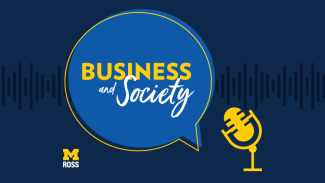Anti-Chinese Bias Harms Asian American Businesses, New Research Finds

An increase in anti-Chinese sentiment has led to consumer discrimination against Asian American-owned small businesses, according to new Ross School of Business research.
In the wake of the COVID-19 pandemic, politicians have spread stigmatizing language, such as former President Trump's usage of “Kung Flu”; media outlets have used dehumanizing images of Asians; and anti-Asian hate crimes have increased. In a new paper published online in Nature Human Behaviour, Michigan Ross Professors Justin Huang and Julia Lee Cunningham and their colleagues examined how this sentiment can damage minority-owned businesses.
Huang recently discussed the research on the new podcast Business and Society with Michigan Ross. A partial transcript appears below; for the full interview, check out the podcast.
We have an unfortunate history in this country of a particular group of people being unjustly blamed for something, followed by hate crimes against individual members of that group. Why does this notion of collective blame arise?
Huang: I think a lot of it is coming from a lack of exposure, and ignorance as well. We studied this in the paper. The more that an individual tended to overestimate that fraction of Asian-Americans that are ethnically Chinese, the more likely they were to blame Chinese or Asians for the spread of the COVID-19 pandemic. And the more likely they are to say, "I think that Chinese food, ordered from a Chinese-American business, presents a higher risk for contracting COVID-19."
In terms of violent attacks, the patterns follow the same way. The less that you know about these groups, the more that you tend to fear and then project blame sentiments toward them.
Why did you choose restaurants to study the economic effects of this bias?
Huang: Restaurants were a great bellwether for broader sentiment toward these ethnic groups because they are ubiquitous and easily ethnically identifiable. These results translate really well to other classes of businesses that are ethnically identifiable — lawyers, doctors, or dentists; landscaping companies; barbers or nail salons or beauty salons. All these businesses are subject to these same forces, whereby if an individual holds these blame sentiments, then that could be expressed in consumer avoidance.
Could you describe some of the impacts you found?
Huang: During the pandemic, we saw that Asian restaurants experienced a drop in traffic of 18.4% on average relative to comparable non-Asian restaurants in the same areas.
Furthermore, unfortunately, former President Trump was creating a lot of stigma through rhetoric like “the China flu” or “Kung Flu.” And in areas that were more Trump supporting, where Trump support was over 75%, we saw relative avoidance as high as 30%. Whereas in low Trump support areas, that relative avoidance was less than 10%.
One other thing that I want to highlight from our results is that this Anti-Asian sentiment tends to be relatively non-targeted. It would be one thing if consumers were only avoiding Chinese restaurants, but more broadly, they are avoiding all Asian restaurants. There wasn't a lot of difference between avoidance of non-Chinese Asian restaurants — Japanese restaurants, Korean restaurants, Vietnamese restaurants — versus Chinese restaurants. Furthermore, that degree of spillover was also moderated by the level of Trump support. So the more Trump-supporting the area was, the more individuals also tended to avoid Korean restaurants too, perhaps out of this misidentification.
Did any of these results surprise you ?
Huang: When we say an 18.4% relative drop, what does that really mean? Our back-of-the-envelope calculations concluded that this cost Asian restaurants around $7.42 billion in lost revenue in the year 2020. That really is a large impact for a large swath of small businesses.
What would you say is the single biggest take-away from this research?
Huang: The biggest take-away is the responsibility of politicians and, unfortunately, media outlets as well. Early in the pandemic, there was this unfortunate article in The New York Times that was reporting on the first COVID-19 case in New York City. And it was reportedly a passenger traveling from Iran. They didn't identify the individual, but the imagery that they utilized to represent this was a picture of a large number of masked Asian-Americans just walking around Chinatown minding their own business. This and similar articles from the time made Asian-Americans the face of the pandemic in a lot of consumers’ and a lot of readers’ minds.
That was combined with Donald Trump’s rhetoric around "The Chinese are bringing the virus into our country," and there wasn't the correct amount of nuance around distinguishing between overseas versus domestic, distinguishing between the Chinese government versus Chinese individuals versus Chinese-Americans.
This really created the perfect storm of an environment for dehumanization and stigmatization, which can lead to attacks, vandalism, and consumer discrimination. So in short, this research underlines the responsibility of a lot of public-facing individuals to make sure to not create stigma around geopolitical events or diseases.







